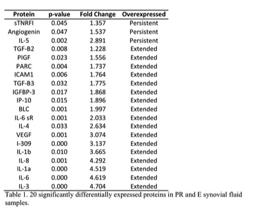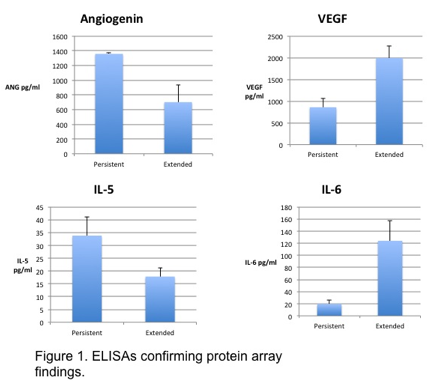Session Information
Session Type: ACR Poster Session C
Session Time: 9:00AM-11:00AM
Background/Purpose: Children
with oligoarticular juvenile idiopathic arthritis (JIA) who have an extended
course (recruitment of 5 or more joints after 6 months of disease) have a worse
prognosis than those who have a persistent oligoarticular course (4 or fewer
joints involved for the duration of disease). We want to predict those patients whose
arthritis will ultimately extend early in the disease course, before the course
has declared itself. Our goal is to identify protein biomarkers
which will discriminate between patients whose involvement will remain
persistently oligoarticular and those who are destined to have an extended
oligoarticular course. Methods: As part of a separate ongoing
IRB approved protocol, remnant synovial fluid was obtained from patients
undergoing medically indicated arthrocenteses. Using our clinical database, JIA
samples were separated into two groups: oligoarticular JIA with persistent
course (PR), oligoarticular JIA with extended course (E). All samples were from
steroid-na•ve joints and samples from E were obtained prior to time of
extension. Using synovial fluid samples from 4 PR and 4 E patients, protein arrays were completed using
RayBiotech Membrane-based Antibody Arrays. Expression of 89 cytokines, chemokines,
and other inflammatory proteins were measured by calculating intensity using
ImageJ. Key significant proteins were then confirmed using R&D Systems
Quantikine Colorimetric Sandwich ELISAs. Results:
Based on the analysis of the protein arrays, 20 proteins had significantly
different expression levels (Table 1). Of these 20, 3 proteins were
overexpressed in PR samples, while 17 were overexpressed in E samples. To
confirm these results, ELISAs (Fig. 1) were performed on IL-5, a cytokine that
acts as a growth and differentiation factor for B cells, Angiogenin, a potent stimulator of new blood vessels, IL-6, an interleukin with
both pro- and anti-inflammatory roles, and VEGF, a signal protein that stimulates
angiogenesis. Both IL-5 and Angiogenin were significantly overexpressed on
protein arrays in PR samples when compared to E samples (p-values
<0.05). VEGF and IL-6 were significantly
overexpressed in E samples when compared to PR samples (p-values <0.001). Conclusion:
Samples of synovial fluid from differing courses of JIA, PR and E, taken before
the ultimate course is clinically apparent, have significantly different protein
levels of important chemokines and cytokines. These differences can be exploited to
predict which patients may extend, allowing earlier therapeutic intervention to
prevent long term disability.
To cite this abstract in AMA style:
Brescia AC, Simonds MM, Sullivan KE, Rose CD. Synovial Fluid Proteins Differentiate Patients with Oligoarticular Juvenile Idiopathic Arthritis Who Are Destined to Extend from Those Who Will Remain Persistent in Course [abstract]. Arthritis Rheumatol. 2015; 67 (suppl 10). https://acrabstracts.org/abstract/synovial-fluid-proteins-differentiate-patients-with-oligoarticular-juvenile-idiopathic-arthritis-who-are-destined-to-extend-from-those-who-will-remain-persistent-in-course/. Accessed .« Back to 2015 ACR/ARHP Annual Meeting
ACR Meeting Abstracts - https://acrabstracts.org/abstract/synovial-fluid-proteins-differentiate-patients-with-oligoarticular-juvenile-idiopathic-arthritis-who-are-destined-to-extend-from-those-who-will-remain-persistent-in-course/


